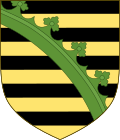You can help expand this article with text translated from the corresponding article in German. (December 2024)Click [show] for important translation instructions.
|
This article needs additional citations for verification .(December 2024) |
Duchy of Saxe-Gotha | |||||||||||||||||||||
|---|---|---|---|---|---|---|---|---|---|---|---|---|---|---|---|---|---|---|---|---|---|
| 1640–1680 | |||||||||||||||||||||
 Thuringia, showing the combined territory of Saxe-Gotha and Saxe-Altenburg from 1672, before it was again divided in 1680 | |||||||||||||||||||||
| Status | State of the Holy Roman Empire | ||||||||||||||||||||
| Capital | Gotha | ||||||||||||||||||||
| Government | Principality | ||||||||||||||||||||
| Historical era | Early modern Europe | ||||||||||||||||||||
| 1640 | |||||||||||||||||||||
| 1644 | |||||||||||||||||||||
| 1672 | |||||||||||||||||||||
• Partitioned in seven | 1680 | ||||||||||||||||||||
| |||||||||||||||||||||
Saxe-Gotha (German : Sachsen-Gotha) was one of the Saxon duchies held by the Ernestine branch of the Wettin dynasty in the former Landgraviate of Thuringia. The ducal residence was erected at Gotha.



